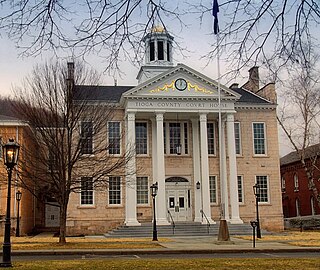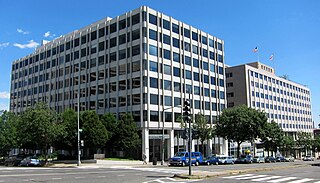Related Research Articles

Tioga County is a county in the Commonwealth of Pennsylvania. As of the 2020 census, the population was 41,045. Its county seat is Wellsboro. The county was created on March 26, 1804, from part of Lycoming County and later organized in 1812. It is named for the Tioga River.

The State University of New York is a system of public colleges and universities in the State of New York. It is one of the largest comprehensive systems of universities, colleges, and community colleges in the United States. Led by chancellor John B. King, the SUNY system has 91,182 employees, including 32,496 faculty members, and some 7,660 degree and certificate programs overall and a $13.37 billion budget. Its flagship universities are Stony Brook University on Long Island and the University at Buffalo.
Special districts are independent, special-purpose governmental units that exist separately from local governments such as county, municipal, and township governments, with substantial administrative and fiscal independence. They are formed to perform a single function or a set of related functions. The term special district governments as defined by the U.S. Census Bureau excludes school districts. In 2017, the U.S. had more than 51,296 special district governments.
A homeowner association, or a homeowner community, is a private association-like entity in the United States, Canada, and certain other countries often formed either ipso jure in a building with multiple owner-occupancies, or by a real estate developer for the purpose of marketing, managing, and selling homes and lots in a residential subdivision. The developer will typically transfer control of the association to the homeowners after selling a predetermined number of lots.
A civil township is a widely used unit of local government in the United States that is subordinate to a county, most often in the northern and midwestern parts of the country. The term town is used in New England, New York, and Wisconsin to refer to the equivalent of the civil township in these states; Minnesota uses "town" officially but often uses it and "township" interchangeably. Specific responsibilities and the degree of autonomy vary in each state. Civil townships are distinct from survey townships, but in states that have both, the boundaries often coincide and may completely geographically subdivide a county. The U.S. Census Bureau classifies civil townships as minor civil divisions. Currently, there are 20 states with civil townships.

The administrative divisions of New York are the various units of government that provide local services in the U.S. State of New York. The state is divided into boroughs, counties, cities, towns, and villages. They are municipal corporations, chartered (created) by the New York State Legislature, as under the New York State Constitution the only body that can create governmental units is the state. All of them have their own governments, sometimes with no paid employees, that provide local services. Centers of population that are not incorporated and have no government or local services are designated hamlets. Whether a municipality is defined as a borough, city, town, or village is determined not by population or land area, but rather on the form of government selected by the residents and approved by the New York State Legislature. Each type of local government is granted specific home rule powers by the New York State Constitution. There are still occasional changes as a village becomes a city, or a village dissolves, each of which requires legislative action. New York also has various corporate entities that provide local services and have their own administrative structures (governments), such as school and fire districts. These are not found in all counties.
A by-law, or as it is most commonly known in the United States bylaws, is a set of rules or law established by an organization or community so as to regulate itself, as allowed or provided for by some higher authority. The higher authority, generally a legislature or some other government body, establishes the degree of control that the by-laws may exercise. By-laws may be established by entities such as a business corporation, a neighbourhood association, or depending on the jurisdiction, a municipality.
A foundation is a category of nonprofit organization or charitable trust that typically provides funding and support for other charitable organizations through grants, but may also engage directly in charitable activities. Foundations include public charitable foundations, such as community foundations, and private foundations, which are typically endowed by an individual or family. However, the term "foundation" may also be used by such organizations that are not involved in public grantmaking.

A charitable organization or charity is an organization whose primary objectives are philanthropy and social well-being.

Most U.S. states and territories have at least two tiers of local government: counties and municipalities. Louisiana uses the term parish and Alaska uses the term borough for what the U.S. Census Bureau terms county equivalents in those states. Civil townships or towns are used as subdivisions of a county in 20 states, mostly in the Northeast and Midwest.

The California Community Colleges is a postsecondary education system in the U.S. state of California. Despite its plural name, the system is consistently referred to in California law as a singular entity. The system includes the Board of Governors of the California Community Colleges and 73 community college districts. The districts currently operate 116 accredited colleges. The California Community Colleges is the largest system of higher education in the United States, and third largest system of higher education in the world, serving more than 1.8 million students.
In the United States, a board often governs institutions of higher education, including private universities, state universities, and community colleges. In each US state, such boards may govern either the state university system, individual colleges and universities, or both. In general, they operate as a board of directors, and they vary by formal name, size, powers, and membership. In some states, members are appointed by the governor.
Laws regulating nonprofit organizations, nonprofit corporations, non-governmental organizations, and voluntary associations vary in different jurisdictions. They all play a critical role in addressing social, economic, and environmental issues. These organizations operate under specific legal frameworks that are regulated by the respective jurisdictions in which they operate.
Governance in higher education is the means by which institutions for higher education are formally organized and managed. Simply, university governance is the way in which universities are operated. Governing structures for higher education are highly differentiated throughout the world, but the different models nonetheless share a common heritage. Internationally, tertiary education includes private not-for-profit, private for-profit, and public institutions governed by differentiated structures of management.
A foundation in the United States is a type of charitable organization. However, the Internal Revenue Code distinguishes between private foundations and public charities. Private foundations have more restrictions and fewer tax benefits than public charities like community foundations.
The New Jersey Library Association (NJLA) is a library organization located in Bordentown, New Jersey. It was established in 1890, and is the oldest library organization in the State of New Jersey. The NJLA began in 1890 with 39 members, and currently has over 1,700. The organization states on its website that it "advocates for the advancement of library services for the residents of New Jersey, provides continuing education & networking opportunities for librarians", and "supports the principles of intellectual freedom & promotes access to library materials for all".
The Law Society of Manitoba (LSM) is the self-governing regulatory body of the legal profession in Manitoba, Canada. Membership in the LSM is required in order to practice law in the province.
Local government in New Jersey is composed of counties and municipalities. Local jurisdictions in New Jersey differ from those in some other states because every square foot of the state is part of exactly one municipality; each of the 564 municipalities is in exactly one county; and each of the 21 counties has more than one municipality. New Jersey has no independent cities, or consolidated city-counties.

Deaccessioning is the process by which a work of art or other object is permanently removed from a museum's collection to sell it or otherwise dispose of it.
Special districts in Illinois are forms of local government that are responsible for a narrow set of responsibilities, as opposed to counties, townships, and municipal governments which have a wide range of responsibilities. School districts and community college boards are not usually considered special-purpose governments despite their narrow focus on education.
References
- 1 2 "Association Libraries | Professional Tools". Ala.org. Archived from the original on 2015-04-02. Retrieved 2015-04-11.
- ↑ "Types of Public Libraries; a Comparison: Library Development: New York State Library". Nysl.nysed.gov. Retrieved 2015-04-11.